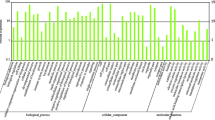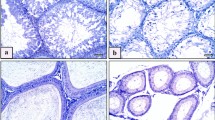Abstract
Oxidative damage has been implicated to be one of main mechanisms by which fluoride (F) induces toxic effects. Previous studies reported that F destroyed the epididymal structure of mouse and rabbit. Epididymis is the important place for sperm maturation. However, little is known about the effect of F on the oxidative stress status of epididymis. Therefore, the aim of the present study was to explore the changes in the activities and transcriptional levels of CuZn superoxide dismutase (CuZn-SOD, SOD1) and catalase (CAT), as well as the ultrastructure, in testis and epididymis of mice administrated with F. Sixty health Kunming mice were randomly divided into four groups. With one group untreated as controls, the others were treated with 25, 50, and 100 mg NaF/L in drinking water. After 10 weeks administration, mitochondrial ultrastructural changes in testis and epididymis were observed, including the incomplete membrane and the dissolved or disappeared cristae. Compared to the control group, the activities of both SOD1 and CAT in testis and epididymis were significantly reduced by 50 or 100 mg NaF exposure. In addition, the mRNA expressions of testicular SOD1 and CAT were also decreased significantly in 100 mg NaF/L group, while the SOD1 and CAT mRNA expressions in epididymides were significantly reduced in all F treatment groups. The above results suggest that in the presence of F, similar to testis, epididymis also loses the balance between oxidative stress and antioxidative defense, and perhaps more sensitive to F.







Similar content being viewed by others
References
Doull J, Boekelheide K, Farishian BG, Isaacson RL, Klotz JB, Kumar JV, Limeback H, Poole C, Puzas JE, Reed N-MR, Thiessen KM, Webster TF (2006) Fluoride in drinking water: a scientific review of EPA’s standards. National Academies Press, Washington
Perumal E, Paul V, Govindarajan V, Panneerselvam L (2013) A brief review on experimental fluorosis. Toxicol Lett 223(2):236–251
Huo M, Han H, Sun Z, Lu Z, Yao X, Wang S, Wang J (2016) Role of IL-17 pathways in immune privilege: a RNA deep sequencing analysis of the mice testis exposure to fluoride. Sci Rep 6:32173
Sun Z, Zhang W, Li S, Xue X, Niu R, Shi L, Li B, Wang X, Wang J (2016) Altered miRNAs expression profiling in sperm of mice induced by fluoride. Chemosphere 155:109–114
Wang HW, Zhao WP, Liu J, Tan PP, Tian WS, Zhou BH (2017) ATP5J and ATP5H proactive expression correlates with cardiomyocyte mitochondrial dysfunction induced by fluoride. Biol Trace Elem Res. https://doi.org/10.1007/s12011-017-0983-5
Niu R, Han H, Zhang Y, Wang J, Zhang J, Yin W, Yin X, Sun Z (2016) Changes in liver antioxidant status of offspring mice induced by maternal fluoride exposure during gestation and lactation. Biol Trace Elem Res 172(1):172–178
Antonio LS, Jeggle P, MacVinish LJ, Bartram JC, Miller H, Jarvis GE, Levy FM, Santesso MR, Leite AL, Oliveira RC, Buzalaf MA, Edwardson JM (2017) The effect of fluoride on the structure, function, and proteome of a renal epithelial cell monolayer. Environ Toxicol 32(4):1455–1467
Ameeramja J, Panneerselvam L, Govindarajan V, Jeyachandran S, Baskaralingam V, Perumal E (2016) Tamarind seed coat ameliorates fluoride induced cytotoxicity, oxidative stress, mitochondrial dysfunction and apoptosis in A549 cells. J Hazard Mater 301:554–565
Adedara IA, Abolaji AO, Idris UF, Olabiyi BF, Onibiyo EM, Ojuade TD, Farombi EO (2017) Neuroprotective influence of taurine on fluoride-induced biochemical and behavioral deficits in rats. Chem Biol Interact 261:1–10
Luke J (2001) Fluoride deposition in the aged human pineal gland. Caries Res 35(2):125–128
Susheela AK, Jethanandani P (1996) Circulating testosterone levels in skeletal fluorosis patients. J Toxicol Clin Toxicol 34(2):183–189
Ortiz-Pérez D, Rodríguez-Martínez M, Martínez F, Borja-Aburto VH, Castelo J, Grimaldo JI, de la Cruz E, Carrizales L, Díaz-Barriga F (2003) Fluoride-induced disruption of reproductive hormones in men. Environ Res 93(1):20–30
Chinoy NJ, Narayana MV, Sequeira E, Joshi SM, Barot JM, Purohit RM, Parikh DJ, Ghodasara NB (1992) Studies on effects of fluoride in 36 villages of Mehsana District, North Gujarat. Fluoride 25(3):101–110
Long H, Jin Y, Lin M, Sun Y, Zhang L, Clinch C (2009) Fluoride toxicity in the male reproductive system. Fluoride 42(4):260–276
Chlubek D (2003) Fluoride and oxidative stress. Fluoride 36(4):217–228
Barbier O, Arreola-Mendoza L, Del Razo LM (2010) Molecular mechanisms of fluoride toxicity. Chem Biol Interact 188(2):319–333
Inkielewicz I, Krechniak J (2003) Fluoride content in soft tissues and urine of rats exposed to sodium fluoride in drinking water. Fluoride 36(4):263–266
Zhang S, Jiang C, Liu H, Guan Z, Zeng Q, Zhang C, Lei R, Xia T, Gao H, Yang L, Chen Y, Wu X, Zhang X, Cui Y, Yu L, Wang Z, Wang A (2013) Fluoride-elicited developmental testicular toxicity in rats: roles of endoplasmic reticulum stress and inflammatory response. Toxicol Appl Pharmacol 271(2):206–215
Orta B, Erkan M (2014) Effects of vitamin C on antioxidant systems and steroidogenic enzymes in sodium fluorideexposed tm4 sertoli cells. Fluoride 47(2):139–151
Yang Z, Song C, Cao X, Zhang F, Zhao H, Du B (2013) Fluoride-induced oxidative damage and dna-protein crosslinks in tm3 mouse leydig cells. Fluoride 46(4):212–217
Chinoy NJ, Sequeira E (1989) Effects of fluoride on the histoarchitecture of reproductive organs of the male mouse. Reprod Toxicol 3(4):261–267
Kumar A, Susheela AK (1995) Effects of chronic fluoride toxicity on the morphology of ductus epididymis and the maturation of spermatozoa of rabbit. Int J Exp Pathol 76(1):1–11
Wang SX, Wang ZH, Cheng XT, Li J, Sang ZP, Zhang XD, Han LL, Qiao XY, ZM W, Wang ZQ (2007) Arsenic and fluoride exposure in drinking water: children's IQ and growth in Shanyin county, Shanxi province, China. Environ Health Perspect 115(4):643–647
Zhang KL, Lou DD, Guan ZZ (2015) Activation of the AGE/RAGE system in the brains of rats and in SH-SY5Y cells exposed to high level of fluoride might connect to oxidative stress. Neurotoxicol Teratol 48:49–55
Shanthakumari D, Srinivasalu S, Subramanian S (2004) Effect of fluoride intoxication on lipid peroxidation and antioxidant status in experimental rats. Toxicology 204(2–3):219–228
Sarkar C, Pal S, Das N, Dinda B (2014) Ameliorative effects of oleanolic acid on fluoride induced metabolic and oxidative dysfunctions in rat brain: experimental and biochemical studies. Food Chem Toxicol 66:224–236
Žaja IŽ, Samardžija M, Vince S, Sluganović A, Strelec S, Šuran J, DelVechio I, Đuričić D, Ostović M, Valpotić H, Milinković-Tur S (2016) Antioxidant protection and lipid peroxidation in testes and different parts of epididymis in boars. Theriogenology 86(9):2194–2201
Fujii J, Iuchi Y, Matsuki S, Ishii T (2003) Cooperative function of antioxidant and redox systems against oxidative stress in male reproductive tissues. Asian J Androl 5(3):231–242
Izquierdo-Vega JA, Sanchez-Gutierrez M, Del Razo LM (2008) Decreased in vitro fertility in male rats exposed to fluoride-induced oxidative stress damage and mitochondrial transmembrane potential loss. Toxicol Appl Pharmacol 230(3):352–357
Garcia-Montalvo EA, Reyes-Perez H, Del Razo LM (2009) Fluoride exposure impairs glucose tolerance via decreased insulin expression and oxidative stress. Toxicology 263(2–3):75–83
Guney M, Oral B, Take G, Giray SG, Mungan T (2007) Effect of fluoride intoxication on endometrial apoptosis and lipid peroxidation in rats: role of vitamins E and C. Toxicology 231(2–3):215–223
Yu Y, Han Y, Niu R, Wang J, Manthari RK, Ommati MM, Sun Z (2017) Ameliorative effect of VE, IGF-I, and hCG on the fluoride-induced testosterone release suppression in mice leydig cells. Biol Trace Elem Res. https://doi.org/10.1007/s12011-017-1023-1
Altintas L, Essiz D, Eraslan G, Ince S, Arslanbas E (2010) Prophylactic effect of N-acetylcysteine against sodium fluoride-induced blood oxidative stress in mice. Food Chem Toxicol 48(10):2838–2841
Nagae M, Nakata M, Takahashi Y (2008) Identification of negative cis-acting elements in response to copper in the chloroplastic iron superoxide dismutase gene of the moss Barbula Unguiculata. Plant Physiol 146(4):1687–1696
Zelko IN, Mariani TJ, Folz RJ (2002) Superoxide dismutase multigene family: a comparison of the CuZn-SOD (SOD1), Mn-SOD (SOD2), and EC-SOD (SOD3) gene structures, evolution, and expression. Free Radic Biol Med 33(3):337–349
Funding
This research was supported by National Natural Science Foundation of China (Grant No. 31201965), Program for the Top Young Innovative Talents of Shanxi Agricultural University (Grant No. TYIT201408), and Program for the Outstanding Innovative Teams of Higher Learning Institutions of Shanxi.
Author information
Authors and Affiliations
Corresponding author
Ethics declarations
Conflict of Interest
The authors declare that they have no conflicts of interest.
Rights and permissions
About this article
Cite this article
Sun, Z., Li, S., Guo, Z. et al. Effects of Fluoride on SOD and CAT in Testis and Epididymis of Mice. Biol Trace Elem Res 184, 148–153 (2018). https://doi.org/10.1007/s12011-017-1181-1
Received:
Accepted:
Published:
Issue Date:
DOI: https://doi.org/10.1007/s12011-017-1181-1




